The Serpent in Mythology and Legends
The word Serpent comes from the Latin Serpentes, meaning "creeping thing" 👨🏫. The Snake Symbol is one of the oldest and most commonly used in many ancient cultures to symbolize wisdom, death, resurrection, fertility and procreation. Although the Snake has mostly positive meanings, it can sometimes represent something evil or harmful, depending on the culture or myth from which it originated.
Who is the serpent in mythology?
The serpent is a prominent figure in many mythologies and cultural stories, often symbolizing complex concepts such as transformation, wisdom, temptation, and power. Here are some of the key serpents in mythology from different cultures:
-
Nagas are serpent-like deities in Hindu and Buddhist mythology, often depicted as half-human, half-snake beings. They are associated with water, fertility, and the earth, and are sometimes considered protectors of treasure and sacred spaces. In some stories, they are seen as guardians of wisdom and spiritual knowledge, while in others, they are feared for their dangerous, sometimes vengeful nature.
2. Jörmungandr (Norse Mythology)
- Also known as the Midgard Serpent, Jörmungandr is a giant sea serpent in Norse mythology, the offspring of the trickster god Loki. It encircles the world and is prophesied to battle Thor during Ragnarök, the end of the world. Jörmungandr represents chaos, destruction, and the cyclical nature of time, as its release brings about cataclysmic change.
3. Quetzalcoatl (Aztec Mythology)
-
Quetzalcoatl, the "Feathered Serpent," is a god in Mesoamerican cultures, including the Aztecs. He is a creator deity associated with the wind, learning, and fertility. The serpent aspect of Quetzalcoatl symbolizes the earth and the underworld, while the feathers represent the heavens and spirituality, making him a symbol of duality, knowledge, and life.
4. Ouroboros (Ancient Egypt and Greece)
- The Ouroboros is an ancient symbol of a serpent eating its own tail, representing the eternal cycle of life, death, and rebirth. It was first seen in Egyptian iconography and later adopted by the Greeks. The Ouroboros symbolizes infinity, wholeness, and the cyclical nature of the universe.
5. The Serpent in the Garden of Eden (Christian and Jewish Mythology)
- In the Bible, the serpent in the Garden of Eden tempts Eve to eat the forbidden fruit, leading to the fall of man. In Christian and Jewish tradition, the serpent is often seen as a symbol of Satan or temptation, representing the deceitful and morally corrupt aspects of life.
6. Kundalini (Hinduism)
- In Hindu spiritual traditions, the Kundalini is depicted as a coiled serpent lying dormant at the base of the spine. When awakened, this serpent energy rises through the chakras, leading to spiritual enlightenment and personal transformation. The serpent here represents potential power and spiritual energy.
7. Python (Greek Mythology)
-
Python was a giant serpent or dragon in Greek mythology, believed to guard the Oracle of Delphi. The god Apollo later defeated Python and claimed the oracle. Python is often associated with the earth and chthonic (underworld) forces, representing chaos, earth, and ancient wisdom.
8. Apep (Egyptian Mythology)
-
Apep (or Apophis) is the serpent god of chaos in ancient Egyptian mythology. Apep is an enemy of the sun god Ra and is said to try to devour the sun each night, symbolizing darkness, evil, and disorder. In Egyptian cosmology, the daily battle between Ra and Apep represents the struggle between order and chaos.
9. Tiamat (Mesopotamian Mythology)
- In Mesopotamian mythology, Tiamat is a primordial chaos serpent or dragon goddess. She represents the ocean and the chaotic waters of creation. Her battle with the god Marduk is a key myth that symbolizes the triumph of order over chaos.
10. Rainbow Serpent (Aboriginal Australian Mythology)
- The Rainbow Serpent is a major deity in Aboriginal Australian mythology, often associated with creation, fertility, and the control of water. It is a creator god that formed the landscape, rivers, and mountains, and is believed to govern the fertility of the land and the people.
11. Caduceus (Greek and Roman Mythology)
- The Caduceus is the staff carried by Hermes (Mercury in Roman mythology), entwined with two serpents. It is a symbol of trade, communication, and negotiation. Though often confused with the Rod of Asclepius (a single serpent entwined staff associated with medicine), the Caduceus has become a modern emblem of medicine and healing.
Serpents in mythology often symbolize dualities such as life and death, wisdom and deceit, creation and destruction. Depending on the cultural context, they can be revered as protectors and sources of wisdom or feared as agents of chaos and danger. This complexity makes the serpent a powerful and enduring symbol across different mythologies
Incredibly, the snake and its meanings can be found in the Myths and Legends of countless cultures around the world! 😮
1) The Serpent in the Bible and in European Mythology
In the earliest versions of the Old Testament, reference is made to the ancestors of the serpent gods. But these references have been eliminated or interpreted as mere character traits of these gods (deceitful and cunning gods 😈 ), by numerous translations and adaptations. The snake is not, therefore, an emissary of the underworld, as one might think at first glance.
The snakes present in the Bible were certainly associated with Moses, for God ordered him to create a serpent-headed Idol. When those bitten by a snake looked at the idol's head, their bite was completely healed. The Staff of Moses is also said to have had magical properties, transforming itself into a snake and back into a staff on one occasion.
A final mention of the Serpent is, of course, found in Genesis: you can't miss Nahash, the famous Serpent in the Garden of Eden, coiled around the Tree of Life.
It's your lucky day! From now on, you too can wear these magnificent Snake Medusa Diamond Pendant

In medieval Europe, the legend of the Basilisk 🐍 was told, a serpent with the body of a dragon that could kill simply by looking at or blowing poisoned air at its victims.
The Fairy Mélusine, another figure of European folklore, was depicted as a cross between a woman, a fish and a snake. She had to spend one day a week in the water, on pain of death.
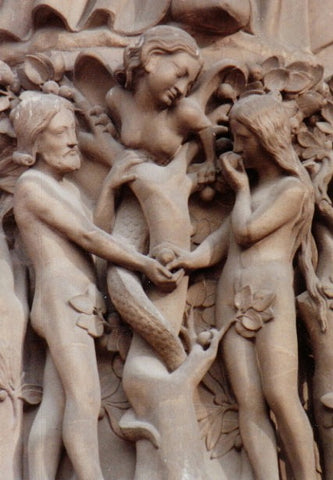
2) The snake in Greek mythology
Greek mythology is very rich and well known today, thanks in particular to the Homeric Poems. In his two main works, the Iliad and the Odyssey, Homer gives rise to many mythological references (the Trojan Horse, Ulysses' journey and his encounter with the Cyclops, etc.). This author has greatly contributed to the richness of Greek culture through his particular literary genre. And any mythology rich enough inevitably includes its share of snakes! 🐍
For the Greeks, the snake symbolizes the guardian spirit. It can be found on many altars dating back to ancient Greece.
It's your lucky day! From now on, you too can wear these magnificent Snake Medusa Diamond Pendant

In Greek legends, the titan Ophion (whose name means "snake"), is said to have ruled the world with Eurynome before the titans Kronos and Rhea overthrew them both ⚔️.
In Athena's temple dedicated to the goddess, a snake held in a cage was believed to be the reincarnation of Erichthonios, the legendary fourth king of Athens. A snake was also kept at the sanctuary of Apollo in Delphi, where it was cared for by a virgin.
What is the most famous snake in mythology?
The most famous snake in mythology is likely the serpent from the Garden of Eden in Christian and Jewish tradition. This snake plays a pivotal role in the Biblical story of creation, found in the Book of Genesis. In the story, the serpent tempts Eve to eat the forbidden fruit from the Tree of Knowledge, leading to the fall of man and the expulsion of Adam and Eve from Eden. This serpent is often interpreted as Satan or a symbol of temptation, deceit, and sin, making it one of the most widely recognized snake symbols in religious and mythological contexts.

Here's a non-exhaustive list of the pantheon of serpent-like creatures, and the names of those Serpents present in epic Greek Mythology:
Medusa and the Gorgons had sharp fangs and live snakes for hair. The image of the Female Serpent recurs frequently in Greek mythology. The Gorgon Medusa was eventually beheaded by Perseus.
The figure of Medea is often depicted being drawn in a chariot driven by snakes.
The Hydra of Lerna, fought by Heracles, son of Zeus, is depicted as having multiple snake heads. The Hydra was popularized by the cartoon "Hercules", which depicts it as a three-headed snake, from which two new heads grow for each head cut off.
The Serpentine Goddess of ancient Minoan civilization was depicted as a woman holding a snake in each hand.
Echidna was a half-woman, half-serpent monster who gave birth to several dragon demi-gods 🐉 by uniting with the evil titan Typhon.
Cecrops had the head and chest of a man on the body of a snake and was a legendary hero to the Athenians. He is one of the few Serpent Men in Greek mythology.
The dyad (a tree-loving nymph) Eurydice dies bitten by a poisonous snake. She ends up in hell, the domain of the god Hades.

Today, there are three Caducei inherited from Greek mythology. The Cup of Hygie symbolizes the pharmaceutical profession, the Staff of Asclepius represents medicine, and the Caduceus of Hermes illustrates commerce and negotiation.
It's your lucky day! From now on, you too can wear these magnificent Snake Medusa Diamond Pendant

What is the name of the legendary serpent?
The name of the legendary serpent can refer to various mythological figures, depending on the culture and tradition. Here are a few notable legendary serpents:
-
Jörmungandr (Norse Mythology) – Also known as the Midgard Serpent, Jörmungandr is a giant sea serpent that encircles the world and is destined to battle Thor during Ragnarök, the end of the world in Norse mythology.
-
Quetzalcoatl (Aztec Mythology) – The Feathered Serpent, a god of wind, wisdom, and creation in Mesoamerican cultures, particularly the Aztecs.
-
Ouroboros (Ancient Symbolism) – The Ouroboros is a serpent or dragon eating its own tail, symbolizing infinity, the cyclical nature of life, and eternal renewal. It appears in ancient Egyptian, Greek, and Gnostic traditions.
-
Python (Greek Mythology) – A serpent that guarded the Oracle of Delphi and was later slain by the god Apollo, associated with the earth and ancient knowledge.
-
Apep (Egyptian Mythology) – Also known as Apophis, Apep is the serpent of chaos and an enemy of the sun god Ra, symbolizing darkness and destruction.
-
Rainbow Serpent (Aboriginal Australian Mythology) – A creator god associated with water, fertility, and the land, who shaped the earth and is one of the most important figures in Aboriginal mythology.
3) The Serpent in Roman Mythology
The Romans borrowed most of their pantheon from the Greeks, but some of their deities were truly unique. Angitia was a healing serpent goddess worshipped by the Marses, a Latin tribe who lived in a mountainous region of central Italy ⛰️ (today known as Abruzzo). A great temple was built for her on the shores of Lake Fucinus, a large lake that was drained in the 19th century.
In classical antiquity, snakes were strongly associated with healing magic. The goddess was renowned for her ability to cure disease and poisoning, especially snakebites. Snakes obeyed her whims and she possessed the power of life and death over them, simply by uttering a word. The lands originally inhabited by the Marses also acquired a magical reputation within the Republic and then the Roman Empire. They were presumed to be the haunt of witches, sorcerers and Supernatural Beings 👻.
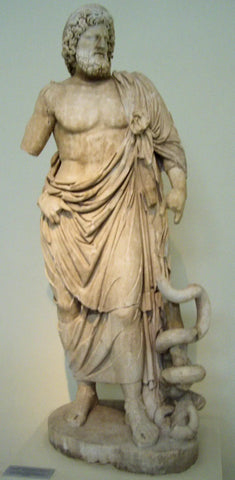
Who is the god of serpents?
The god of serpents appears in various mythologies, with different deities associated with snakes or serpents. Here are a few notable examples:
1. Vasuki (Hindu Mythology)
-
Vasuki is a king of serpents, or Nāgas, in Hindu mythology. He is often depicted as a giant cobra and is associated with wisdom and power. He played a key role in the churning of the ocean of milk (Samudra Manthan), where he served as a rope around Mount Mandara.
2. Quetzalcoatl (Aztec Mythology)
-
Quetzalcoatl, the Feathered Serpent, is one of the most important gods in Mesoamerican cultures, particularly among the Aztecs. He represents wisdom, wind, and fertility, and his serpentine form connects him with the earth and the heavens.
3. Apep (Egyptian Mythology)
-
Apep, also known as Apophis, is an Egyptian serpent god of chaos and destruction. He is considered the enemy of the sun god Ra, representing the forces of darkness and evil, and attempts to devour the sun each night.
4. Naga (Hindu and Buddhist Mythology)
-
Nagas are serpent deities in Hindu and Buddhist mythology. They are often associated with water, fertility, and the underworld. In some traditions, they are considered protectors and are revered, while in others, they are more fearsome beings.
5. Tiamat (Mesopotamian Mythology)
-
Tiamat is a primordial serpent or dragon goddess in Mesopotamian mythology. She is the personification of the ocean and chaos, representing both creation and destruction. Her conflict with the god Marduk represents the battle between chaos and order.
6. Glycon (Ancient Greek/Roman Mythology)
-
Glycon was a serpent god worshipped in the Roman Empire, primarily as a healing deity. The cult of Glycon, which was prominent in the 2nd century AD, was founded by the prophet Alexander of Abonoteichus.
4) The serpent in Norse mythology
Norse mythology mentions a titanic serpent living in the ocean: Jörmungand. Jörmungand is the son of Loki, god of discord, and the giantess Angrboda.
Jörmungand is the famous guardian monster of Midgard, the world of humans (as opposed to Asgard, the world of the gods). He is the god of the sea, hiding in its abysses. In mythical accounts, the serpent's body is supposed to form a circle around Midgard, biting its own tail, in the manner of the Ouroboros. According to Nordic legends, when Jörmungand releases his tail, Ragnarök will begin and the world will fall apart.
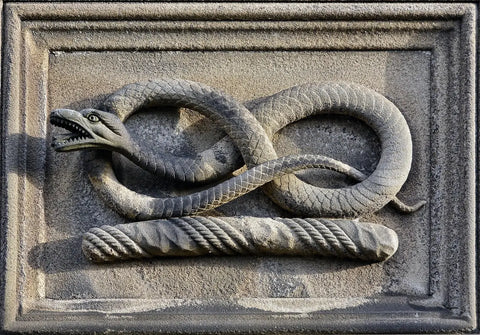
Jörmungand's sworn enemy is none other than Thor, the god of thunder. In one Norse legend, Thor tries to catch Jörmungand by draining the ocean (or by catching him with a fishing rod, we're not sure 😅 ), but he fails and the snake returns to the abyss.
It's your lucky day! From now on, you too can wear these magnificent Snake Medusa Diamond Pendant

There's another dreaded snake in Scandinavian legends: Nídhögg. This creature is an evil serpent coiled around the third root of Yggdrasill, the World Tree. Nídhögg gnaws away at this sacred tree from below, along with the bones and corpses of murderers, traitors and adulterers 💀.
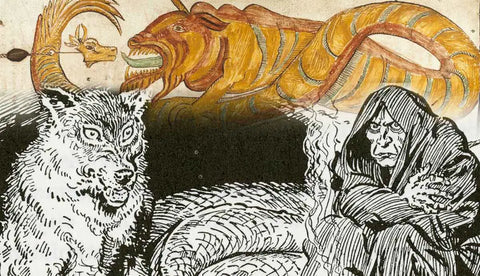
It was not uncommon for Nordic warriors to wear jewelry and artifacts bearing the effigy of these legendary creatures. They did so to protect themselves from evil spirits, to recount their exploits or to honor the gods.
Who is the Greek god snake?
In Greek mythology, serpents and snakes are often associated with various gods and mythological figures, but Asclepius, the god of medicine and healing, is most closely linked with snakes. His staff, known as the Rod of Asclepius, features a single serpent coiled around it and has become a universal symbol of medicine.
5) The snake in Celtic mythology
Celtic mythology associates snakes with wisdom, fertility and immortality. The Celts tended to link them to healing pools and water 💧. They apparently attributed the same properties to the Serpent's Egg, a smooth egg-shaped stone said to have magical powers comparable to those of the Grail or the Philosopher's Stone. Snakes were often depicted on Celtic altars.
There is a legend that Saint Patrick rid Ireland of the snakes that represented the ancient cults, thus driving out the ancient Celtic polytheistic beliefs in favor of the Christian religion ✝️.

Who is the serpent in Egyptian mythology?
In Egyptian mythology, the primary serpent figure is Apep, also known as Apophis. Apep is the god of chaos and destruction and represents darkness and evil. He is depicted as a giant serpent or dragon who is the eternal enemy of the sun god Ra.
Apep's Role in Egyptian Mythology:
-
Apep vs. Ra: Apep is seen as the force of chaos (Isfet), constantly trying to disrupt Ma'at (order) by stopping Ra from rising and bringing light to the world. Every night, Apep would attempt to devour Ra's solar barque (the boat Ra uses to travel through the underworld during the night) and prevent the sun from rising. Ra's defeat of Apep each morning symbolizes the victory of order over chaos and light over darkness.
-
Battles in the Underworld: Ra is often aided in his battles with Apep by other gods, including Set, the god of storms and war, who, in some versions of the myth, helps to defend Ra against Apep’s attacks.
Symbolism of Apep:
Apep symbolizes darkness, destruction, and chaos. As the enemy of Ra, he is considered a representation of all the destructive and disorderly forces in the world. Egyptian mythology framed Apep’s constant defeat as part of the cosmic balance, with his recurring attempts to swallow the sun illustrating the constant battle between order (Ma'at) and chaos (Isfet).
Apep is one of the most prominent and feared serpentine figures in Egyptian mythology, embodying evil forces in opposition to the gods who uphold balance and harmony.
6) The Serpent in American (Pre-Columbian) Mythology
In Central America, the ancient Mayan sacred book "Chilam Balam" asserts that the first inhabitants of Yucatan were the Chanes, or People of the Serpent. Sources cite the Chanes as being led across the sea by the serpent-god Itzamna, who ruled through his esoteric knowledge rather than his strength 💪. Feathered snakes (which seemed to have the ability to fly) were also much represented in Mayan symbolism.
It's your lucky day! From now on, you too can wear these magnificent Snake Medusa Diamond Pendant

The Aztecs, another pre-Columbian Central American people, also worshipped a snake god: Quetzalcoatl. He too was a feathered mythological figure, who brought the knowledge of science and mathematics to his people 📚.

7) The snake in Native American mythology
Native American tribes regarded the snake as a symbol of fertility and rebirth. In their mythology, Unhcegila was a giant snake-like creature that could swallow a human whole 😓! Native American mythology also included a symbol representing a serpent deity called Avanyu, who brought storms to the earth.
The Hopis of North America performed a Serpent Dance to influence the weather and invoke the gods. After the ceremony, captured snakes were released so that they could carry the priests' prayers into the underworld, where the rain gods were believed to live 🌧️.
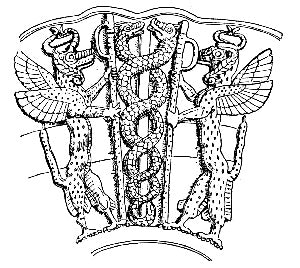
According to the story of California's Diegueño Indians, humans obtained many of the secrets of civilization from a huge snake named Umai-hulhlya-wit. This snake lived in the ocean until the Diegueño organized a ceremony and summoned it to dry land. They built an enclosure for him, but it was too small to hold him. After Umai-hulhlya-wit fled the enclosure, the Indians set it on fire 🔥. Legend has it that the serpent's body then exploded, flooding the land with the knowledge, secrets, songs and other cultural treasures it contained.
It's your lucky day! From now on, you too can wear these magnificent Snake Medusa Diamond Pendant

Who is the great serpent in Greek mythology?
In Greek mythology, one of the most famous "great serpents" is Python, a giant serpent or dragon associated with the Oracle of Delphi. Python was said to have been born from the earth and was a guardian of the Delphic oracle, which was a center of prophecy and wisdom.
Key Points About Python:
-
Connection to Delphi: Python was a protector of the sacred oracle at Delphi, believed to be a powerful source of divine prophecy.
-
Apollo's Victory: The god Apollo eventually killed Python to take control of the oracle. After defeating the serpent, Apollo established his own sanctuary at Delphi and became the god associated with prophecy and oracles.
Python is an important figure in Greek mythology, particularly for the story of Apollo and Delphi. This myth also symbolizes the transition from older earth-centered divinities to the Olympian gods, like Apollo, who brought new religious practices and order.
Other notable serpentine figures in Greek mythology include Ladon, the serpent who guarded the golden apples in the Garden of the Hesperides, and Hydra, the multi-headed serpent defeated by Heracles during his Twelve Labors. However, Python is the most significant "great serpent" in relation to Greek mythology's religious and prophetic traditions
8) The Serpent in Egyptian Mythology
In Egyptian mythology, the snake is associated with immortality and the gods of the Old and Middle Kingdom. A snake was depicted on the tombs of the Pharaohs ⚰️. This animal was supposed to take them to heaven, to the land of the gods.
The snake thus became a symbol of royalty in Ancient Egypt. It could, for example, be found on the headdress of the pharaohs in the form of the female cobra Uræus, supposed to protect the pharaoh from his enemies.
But the symbolism attached to the Serpent in the historical period of the New Kingdom was turned upside down. It was during this period that Egypt was invaded by the Hyksos people from Asia. The snake changed its meaning to represent the invaders, and was thus considered a symbol of evil.
The Egyptian serpent goddess was named Wadjet. She was the patron deity of the city of Dep and was also considered the protector of kings and pregnant women 🤰. Wadjet was represented in the form of a venomous Egyptian cobra or a snake-headed woman.
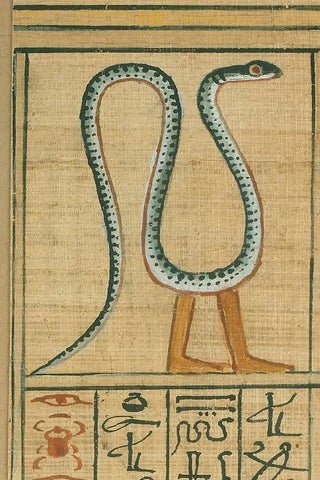
The Egyptians also believed that the god Amon could transform himself into a snake to regenerate. They claimed that the underworld in their mythology was guarded by Nehebkau, a two-headed guardian serpent. Finally, the Egyptians represented Apophis (the god of evil and chaos), as a giant venomous snake.
Egyptian mythology also mentions a circular snake, eating its own tail. This animal, named Ouroboros, symbolized renewal and resurrection. It was depicted on a shrine in Tutankhamun's tomb.
It's your lucky day! From now on, you too can wear these magnificent Snake Medusa Diamond Pendant

What does a serpent symbolize?
A serpent has been a powerful and complex symbol across various cultures and belief systems throughout history. Its symbolism varies greatly, often representing both positive and negative concepts. Here are some of the key symbolic meanings of the serpent:
1. Transformation and Rebirth:
- The serpent is often associated with rebirth and transformation due to its ability to shed its skin. In this sense, the snake symbolizes renewal, regeneration, and the cyclical nature of life. This is particularly evident in Hindu and Native American traditions.
2. Wisdom and Knowledge:
- In many cultures, serpents symbolize wisdom and knowledge. For example, in Ancient Greece, the snake is linked to Asclepius, the god of medicine and healing, and to Hermes, through the symbol of the Caduceus, a staff with two intertwined serpents, representing communication and healing.
3. Temptation and Deceit:
- In the Bible, the serpent is depicted as a symbol of temptation and deceit, particularly in the story of the Garden of Eden, where the snake tempts Eve to eat the forbidden fruit. This story has given the snake a negative connotation in Christianity as a symbol of sin, evil, and cunning.
4. Healing and Medicine:
- The serpent is a prominent symbol in healing traditions. The Rod of Asclepius, featuring a serpent coiled around a staff, is an ancient symbol of medicine and is still widely used in medical contexts today.
5. Immortality and Eternity:
- The Ouroboros, a serpent eating its own tail, is an ancient symbol of eternity and the infinite cycle of life, death, and rebirth. It represents the idea of the eternal return and the interconnectedness of all things.
6. Protection:
- In some cultures, serpents are revered as protective spirits. In Hinduism, Nagas (serpent deities) are considered guardians of water bodies and treasure. Similarly, in Ancient Egypt, the serpent was seen as a protector of the pharaoh and was featured on royal crowns.
7. Chaos and Destruction:
- In other contexts, serpents represent chaos and destruction. For instance, the Egyptian serpent Apep (or Apophis) symbolizes chaos and evil, constantly battling with the sun god Ra to destroy the order of the cosmos.
8. Sexuality and Fertility:
- In many cultures, serpents are linked to fertility and sexuality, due to their phallic shape and their connection to the earth and water—both elements associated with fertility.
9. Duality:
- The serpent often represents duality, embodying both positive and negative aspects of life. It can be both a symbol of life and death, creation and destruction, wisdom and deceit, showing the balance between opposing forces.
The serpent is a multifaceted symbol that encompasses a wide range of meanings, from wisdom and healing to temptation and chaos. Its interpretation depends largely on the cultural or religious context, but it is often associated with themes of transformation, duality, and the cycle of life.
9) The Serpent in African Mythology
In African mythology, an ancient god is said to have created the sun, the moon and then the world, from a lump of clay. The god also created a set of twin primordial beings, called "Nummo". According to the Dogon people of Mali, these twins were half-human and half-snake. In African tales and legends, these ancestral spirits were immortal ⚰️❌. They were even said to have come from another world, and to have participated in the creation of many animal species on Earth.
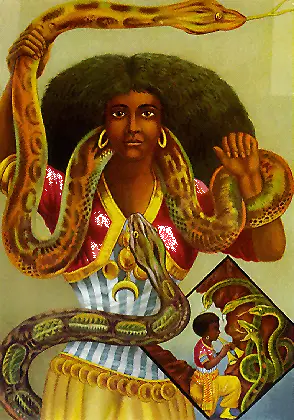
The history of the Fon people of West Africa tells the legend of Aido-Hwedo. This cosmic serpent, revered as a god, carried the founding couple of Mawu and Lisa in its mouth to form the primordial world 👫🏾. Once this work was completed, Mawu and Lisa ordered Aido-Hwedo to encircle the Earth to hold it in place. The earthquakes were caused by the snake's sudden movement. Here again, we find the symbolism of the Ouroboros.
It's your lucky day! From now on, you too can wear these magnificent Snake Medusa Diamond Pendant

10) The Snake in Chinese Mythology
The Chinese Snake-God is described as the famous dragon with the characteristic long-line form, in the mythology of this people 🐲. But ancient sources claim that this Dragon-Serpent most likely refers to the winged-legged serpent of Hindu mythology, called Naga.
In Chinese mythology, human beings are said to have been created by Fu Xi and Nu Wa (two Chinese mythological heroes), according to an ancient Chinese legend. The pair of heroes were depicted as snakes with human heads. According to legend, the duo contributed to the development of the Chinese writing system 🈶. These two characters also represent the personality traits of intelligence, wisdom and communication, which the snake represents in the Chinese Zodiac. Fu Xi and Nu Wa are believed to have actually existed in Chinese history, but without being endowed with snake-like traits!
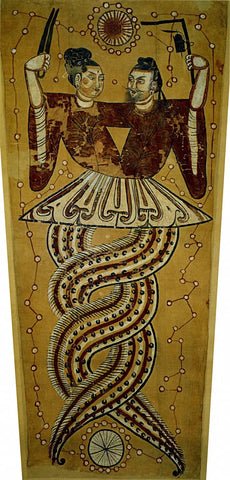
11) The Serpent in Japanese Mythology
Benzaiten is the Japanese goddess of fertility, flowing rivers and waters, language and poetry, music, dance, wealth and good fortune (no less!). Benzaiten is the only female figure among the "Seven Divinities of Happiness". She most often appears wearing a white snake as a headdress. Dragons and snakes are her messengers and avatars, and she herself can appear as a white snake. Benzaiten is one of Japan's most revered deities, and every major Japanese city today still has a shrine or temple dedicated to Benzaiten 🏯. The latter is often located near a body of water such as a lake, pond, river or the sea.
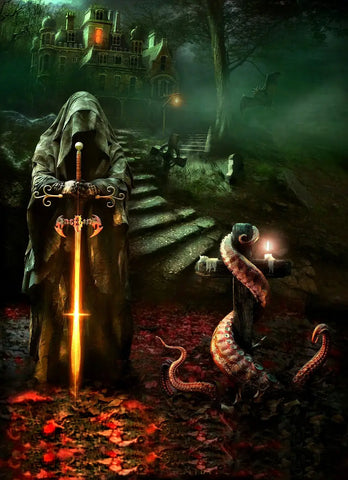
In Japanese mythology, snakes are considered a minor type of dragon and share many of the creature's mythical traits. As in Chinese mythology, Japanese dragons are associated with water (particularly rivers) and although they are powerful and potentially frightening, both Chinese and Japanese traditions honor them as benevolent, just and wise.
Thanks to their ability to continually shed their skin and be reborn, these snakes are known as Metamorphs in Japanese mythology. They can live for thousands of years ♾️, and are able to walk between the underworld, the sky and the human world. Even today, meeting a living snake is considered an extremely happy omen in Japan. Meeting a dead snake, on the other hand, is considered a sign of impending misfortune.
It's your lucky day! From now on, you too can wear these magnificent Snake Medusa Diamond Pendant

12) The Serpent in Indian Mythology
In ancient and current Indian beliefs, the Nagas are an ancient race of snakes that descended from the sky. The Ancient Book of Dzyan 📖, probably one of the oldest Sanskrit sources, speaks of ancient Indian myths and mentions these fantastic creatures.
Nagas live in underwater or subterranean realms. They control rainfall and interact with deities and humans in a variety of ways. Some are good, while others can be cruel and vengeful.

Nagas are said to have a human body above the waist, and to possess the tail of a dragon or snake 🤔. They can also transform into an entirely human creature or an entirely serpentine form. Female Naga (Nagis) are described as extremely beautiful creatures, so much so that ancient Indian dynasties claimed their family origin as coming from the union of a human and a Nagi.
There are many references to the snake in Hindu myths:
Kaliya was a five-headed serpent king who poisoned water and earth until the god Krishna defeated him in battle ⚔️.
Kadru was a serpent goddess who had 1,000 children. Legend has it that they still live today as snakes in human form.
Shesha: a snake-like creature said to be the king of the Nagas, and one of Kadru's sons.
Manasa: said to be the queen of the Nagas.
Muchalinda, a serpent king who protected Buddha from a violent storm.
It's your lucky day! From now on, you too can wear these magnificent Snake Medusa Diamond Pendant

13) Rainbow Snake Aboriginal mythology
The legends of the aborigines of northern Australia tell how the great Rainbow Serpent Goddess Julunggul (also called Kalseru-Dupa), shaped the world. When human blood fell into a pond, Julunggul became angry 😠. She sent a giant wave of water over the world. Then she swallowed people, plants and animals. Julunggul rose to the sky, but an ant spirit bit her and made her vomit up what she'd swallowed. This happened several more times, until Julunggul finally left the earth, leaving men, plants and animals in her wake. The Serpent of Australian Mythology may not be the most benevolent, but he's certainly the most colorful!
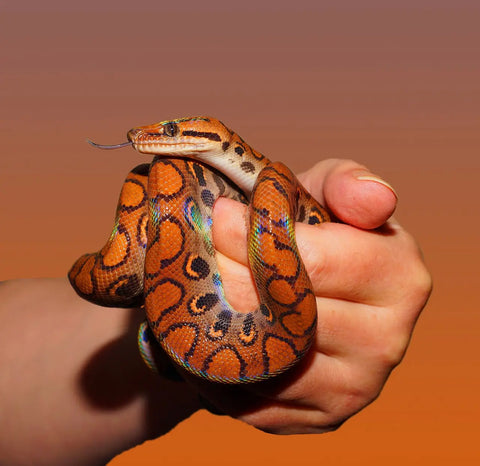
In conclusion, the snake is one of the Mythological Figures common to all peoples, regardless of region 🗺️ or era ⌛. Which is unique!
Snakes have not always been associated with evil in all cultures and eras, as they are in Christianity. On the contrary, these beings were often symbols of power, not just monsters. As deities, they could also offer protection to the mortals who worshipped them 👍.
It's your lucky day! From now on, you too can wear these magnificent Snake Medusa Diamond Pendant

At Snake Label® we want to honor these magnificent but often misunderstood reptiles. We want to change the negative view of snakes held by most people. Our passion for these animals shines through in our snake-themed clothing, jewelry and accessories.
Dive into the fascinating world of snakes and explore our other articles now!
Stay Updated!
Don't miss out on the latest insights, tips, and exclusive content. Subscribe to our blog newsletter today and be the first to know about new posts, special offers, and more!
Join our community now—just enter your email below to stay connected.